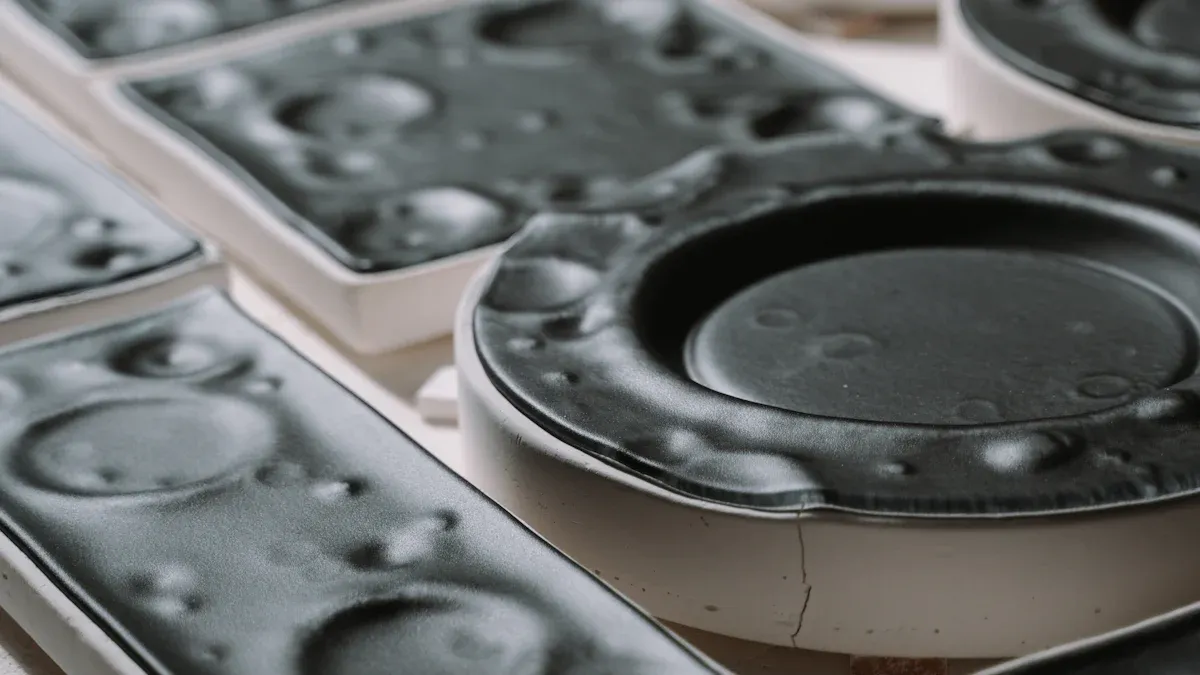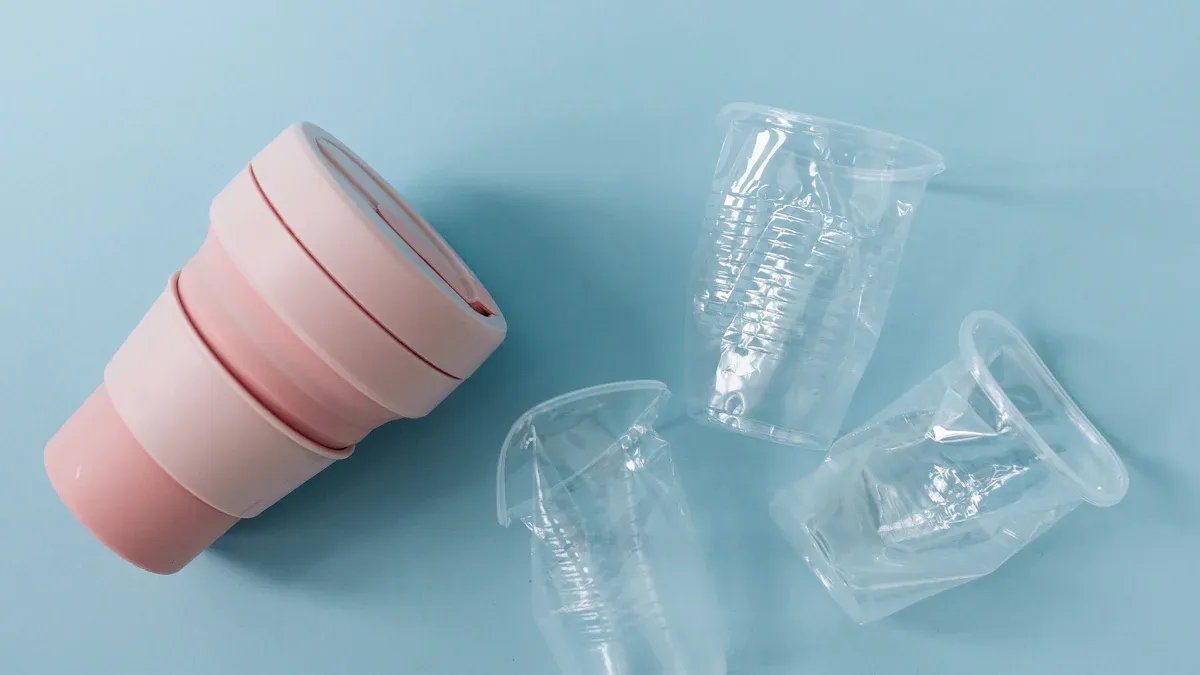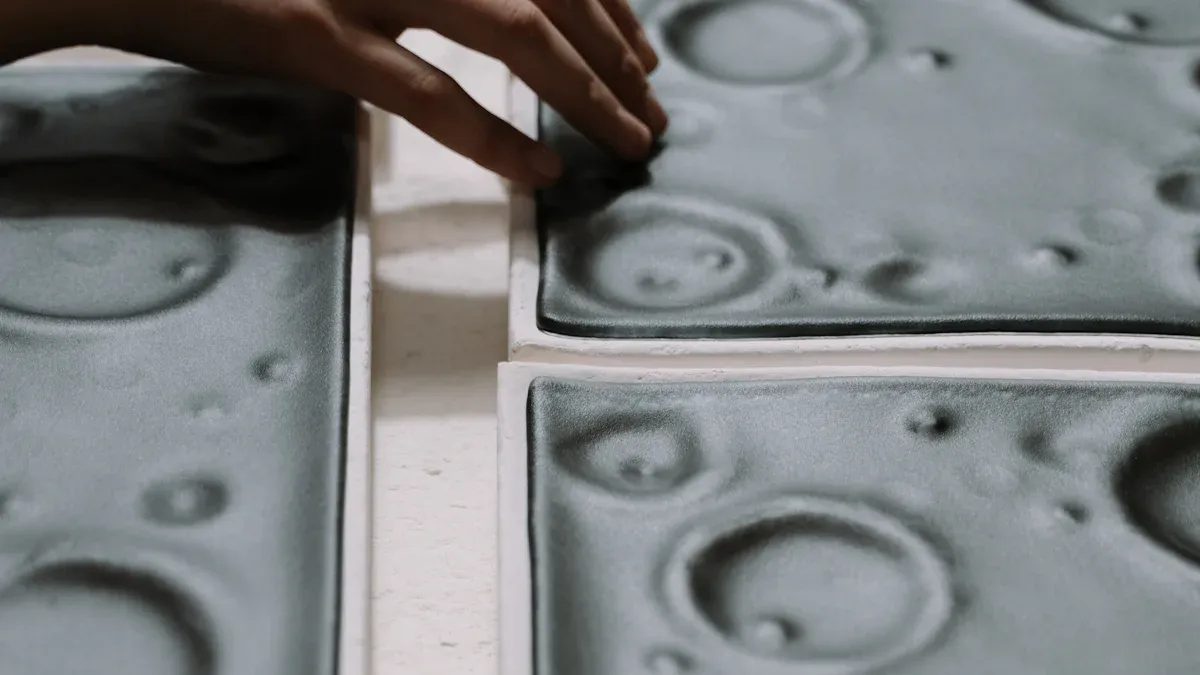
Overmolding is a multi-step injection molding process that combines two or more materials into a single product. This technique allows you to achieve a seamless bond between plastic and rubber, ensuring both strength and functionality. By integrating materials, overmolding enhances durability, making it a preferred choice in industries like automotive and electronics.
The global overmolding market, valued at $3.45 billion in 2021, continues to grow at a 6.5% annual rate. This growth reflects its effectiveness in improving product performance and longevity. Overmolding Techniques not only produce durable products but also create visually appealing designs that enhance user experience.

Overmolding is a manufacturing process that combines two materials into a single, cohesive product. It involves molding one material over another to create parts with enhanced functionality, durability, and aesthetics. You can use this technique to bond plastics and rubbers seamlessly, ensuring the final product meets specific performance requirements.
Research studies highlight the efficiency of overmolding techniques, particularly in thermoplastic composite overmolding. These studies show that optimized processes reduce energy consumption and improve bonding strength. For example:
- Single-step processes eliminate microcracks and enhance interface strength.
- Fiber migration during overmolding creates mechanical interlocking, boosting durability.
By understanding these principles, you can leverage overmolding to produce reliable and high-performing products.
The overmolding process consists of several key steps that ensure the materials bond effectively:
1. Substrate Preparation: The base material, or substrate, is cleaned and prepared to ensure proper adhesion. Surface preparation techniques, such as roughening or applying primers, improve bonding.
2. First Injection: The substrate is molded using the first material, typically a thermoplastic. This step forms the foundation of the product.
3. Second Injection: The second material, often rubber or a softer thermoplastic, is injected over the substrate. This creates the final product with a seamless bond between the two materials.
4. Cooling and Ejection: The product is cooled to solidify the bond and then ejected from the mold.
Numerical metrics illustrate the importance of precision during these steps:
| Metric | Value Range |
|----------------------------|---------------------------------|
| Recommended L/T Range | 80-120:1 |
| Minimum TPE Wall Thickness | 1.016 mm |
| TPE Shrinkage Values | 0.051 mm to 0.356 mm per inch |
| Other Thermoplastic Shrinkage | 0.051 mm to 0.356 mm per inch |
By following these steps and adhering to recommended metrics, you can achieve consistent results in your manufacturing process.
The rubber overmolding process is a specialized technique that combines the strength of substrates with the flexibility and impact-absorbing properties of rubber. This process is ideal for creating ergonomic and durable parts.
Rubber overmolding enhances product performance in demanding environments. For instance:
- Industrial products gain strength, thermal stability, and chemical resistance.
- Surgical instruments benefit from non-slip grips, improving precision and reducing hand fatigue.
- Tools with overmolded rubber handles offer better grip and comfort, showcasing the practical benefits of this technique.
A notable example includes resolving gasket leaks in cartridges through rubber overmolding, ensuring reliable results and streamlining manufacturing. By incorporating this process, you can create parts that excel in both functionality and user experience.
Plastics play a crucial role in overmolding materials. You can choose from a variety of thermoplastics depending on the product's requirements. Common options include polypropylene (PP), polycarbonate (PC), and acrylonitrile butadiene styrene (ABS). These materials offer excellent strength, durability, and resistance to wear.
Polypropylene is lightweight and resistant to chemicals, making it ideal for automotive and medical applications. Polycarbonate provides high impact resistance and transparency, which works well for electronics and optical components. ABS combines toughness with a smooth surface finish, making it a popular choice for consumer products.
When selecting plastics, consider factors like thermal stability, shrinkage rates, and compatibility with the overmolded rubber. This ensures a strong bond and optimal performance.
Rubbers add flexibility and comfort to overmolded products. Thermoplastic elastomers (TPEs) are the most commonly used rubbers in overmolding materials. They combine the elasticity of rubber with the processability of plastics. Silicone rubber is another excellent choice, especially for applications requiring heat resistance and biocompatibility.
TPEs are versatile and available in various hardness levels. You can use them to create soft-touch grips, seals, or vibration-dampening components. Silicone rubber excels in medical devices due to its non-toxic and hypoallergenic properties.
Rubber over rigid plastic is a common combination in overmolding. This pairing enhances grip, comfort, and durability in products like tools, handles, and wearable devices.
Overmolding material compatibility is critical for achieving a seamless bond. You must ensure that the plastic and rubber adhere well to each other. Factors like chemical properties, thermal expansion rates, and processing temperatures influence compatibility.
Surface preparation also plays a key role. Cleaning, roughening, or applying primers can improve adhesion between materials. Testing different combinations of plastics and rubbers helps you identify the best match for your product.
By carefully selecting overmolding materials and ensuring compatibility, you can create products that are durable, functional, and visually appealing.
Achieving strong bonding in overmolding is essential for creating durable and reliable multi-material molded parts. Whether you are bonding rubber onto substrates or combining plastics and rubbers, the right techniques ensure seamless integration and optimal performance. Below, you will explore three key methods to enhance bonding in overmolding.
Chemical bonding plays a critical role in ensuring a strong connection between materials in overmolding. This method relies on the chemical compatibility of the materials used. When you select materials with complementary chemical properties, they form a molecular-level bond during the molding process.
For example, thermoplastic elastomers (TPEs) often bond well with certain plastics due to their similar chemical structures. Adhesion promoters or primers can further enhance this bond by creating a reactive layer on the substrate. These substances improve the interaction between the substrate and the overmolded material, resulting in a stronger bond.
Chemical bonding is particularly effective when creating high-performance seals. These seals require a tight, leak-proof connection between materials, which chemical bonding can achieve. By focusing on material compatibility and using adhesion enhancers, you can ensure the success of your multi-material components.
Mechanical bonding relies on the physical interlocking of materials to create a strong connection. This technique is especially useful when bonding rubber to metal substrates or bonding rubber to plastic substrates. By designing the substrate with grooves, undercuts, or textured surfaces, you can increase the surface area for the overmolded material to grip onto.
For instance, when creating a multi-component part, you can incorporate mechanical features into the substrate design. These features allow the overmolded material to flow into and around them during the molding process. Once the material solidifies, it forms a secure mechanical bond that enhances the durability of the final product.
Mechanical bonding is ideal for applications requiring high-performance seals or products exposed to mechanical stress. By combining this technique with chemical bonding, you can achieve even greater strength and reliability in your multi-material composite designs.
Surface preparation is a crucial step in the overmolding process. Proper preparation ensures that the substrate is clean, free of contaminants, and ready to bond with the overmolded material. Without adequate preparation, even the best materials and techniques may fail to achieve a strong bond.
You can use several methods to prepare the substrate surface. Cleaning removes dirt, grease, and other contaminants that can interfere with bonding. Roughening the surface increases its texture, providing more area for the overmolded material to adhere to. Applying primers or adhesion promoters creates a chemical bridge between the substrate and the overmolded material, further enhancing adhesion.
Surface preparation is especially important when bonding rubber to plastic substrates or bonding rubber to metal substrates. These combinations often require additional steps to ensure a seamless bond. By investing time in surface preparation, you can improve the quality and performance of your multi-material components.
Overmolding enhances the durability of your products by creating a protective layer around components. This layer shields parts from wear, impacts, and environmental factors, significantly extending their lifespan. For example, overmolded soft rubber handles provide excellent grip and resist damage from repeated use. Additionally, the shock absorption properties of rubber improve the reliability of parts in high-stress applications.
The process also ensures a seamless bond between materials, reducing the risk of delamination or failure. This makes overmolding ideal for products exposed to harsh conditions, such as automotive components or industrial tools. By choosing overmolding, you can create parts that withstand the test of time while maintaining their functionality.
Overmolding offers unparalleled design freedom, allowing you to create intricate and customized solutions. You can combine different materials, textures, and colors to enhance both the functionality and aesthetic appeal of your products. For instance, overmolding enables the production of ergonomic designs, such as soft rubber handles, that improve user comfort and usability.
The ability to mold complex shapes and integrate multiple functions into a single part simplifies the design process. This flexibility opens up new possibilities for innovation, whether you are designing consumer electronics, medical devices, or automotive interiors. With overmolding, you can bring your creative ideas to life without compromising on performance or quality.
| Benefit | Description |
|---|---|
| Design Flexibility | Overmolding allows for customized solutions and intricate designs, enhancing aesthetic appeal. |
| Durability | Provides a protective layer to components, increasing lifespan and reliability against impacts. |
| Cost Efficiency | Simplifies manufacturing, reduces assembly time, and improves overall product quality. |
Overmolding streamlines the manufacturing process by combining multiple materials into a single part. This eliminates the need for additional assembly steps, reducing production time and labor costs. The process also minimizes material waste, making it an environmentally friendly option.
By improving product quality and reducing defects, overmolding lowers the overall cost of production. For example, the seamless integration of materials ensures consistent performance, reducing the need for repairs or replacements. Whether you are producing high-volume consumer goods or specialized industrial parts, overmolding offers a cost-effective solution that enhances efficiency and profitability.

Overmolding plays a vital role in the automotive industry by enhancing the durability and functionality of various parts. You can find overmolded components in steering wheels, gear knobs, and dashboard controls. These parts benefit from improved grip, vibration dampening, and resistance to wear.
The adoption of advanced overmolding techniques, such as 2-shot molding, has grown steadily in the automotive sector.
- In 2023, the industry saw a 5% increase in the use of these techniques.
- Projections for 2024 suggest an additional 6% growth.
- This trend reflects the rising demand for sophisticated and durable automotive parts.
By leveraging custom rubber overmolding services, manufacturers can create ergonomic designs that enhance driver comfort and safety. Overmolding also allows for the integration of multiple functions into a single part, reducing assembly time and costs.
In electronics and consumer products, overmolding enhances both functionality and aesthetics. You can see its impact in items like smartphone cases, power tool grips, and wearable devices. Overmolding provides a soft-touch finish, making these parts more comfortable to use.
This process also protects electronic components from moisture, dust, and impact. For example, overmolded connectors and cables offer superior durability and reliability. The seamless bond between materials ensures that these parts maintain their performance even in challenging environments.
Overmolding enables manufacturers to combine different colors and textures, creating visually appealing designs. This versatility makes it a popular choice for consumer products where both form and function matter.
Overmolding significantly improves the safety and usability of medical devices. By encapsulating electronic components in biocompatible materials, it ensures patient safety and device reliability. Blood glucose meters, for instance, benefit from this process by becoming easier to sterilize and more ergonomic for users.
The integration of soft rubber grips through overmolding enhances user interaction and reduces hand fatigue during prolonged use. This process also allows for the seamless combination of rigid and flexible parts, making medical devices more functional and durable.
Custom rubber overmolding services play a crucial role in meeting the stringent requirements of the medical industry. By choosing this technique, you can create parts that prioritize both patient safety and user comfort.
Overmolding combines materials like plastics and rubbers to create durable, functional, and visually appealing products. You can achieve seamless bonding by following precise techniques, such as chemical and mechanical bonding, and by selecting compatible materials. This process enhances product performance and simplifies manufacturing.
Consider the following examples of overmolding's impact:
| Technique | Application | Outcome |
|---|---|---|
| 2K Molding | Car dashboard manufacturing | Improved aesthetics, tactile feel, and reduced assembly steps. |
| Overmolding | Smartphone case production | Added non-slip surface, enhancing user comfort and product durability. |
By adopting overmolding, you can unlock innovative design possibilities while improving efficiency and quality.
Overmolding involves molding one material over another to create a seamless bond. Insert molding, on the other hand, embeds a pre-made component (like metal) into the plastic during the molding process. Both techniques enhance product functionality but serve different purposes.
Not all plastics and rubbers are compatible. You must select materials with similar chemical properties and thermal expansion rates. Testing combinations ensures a strong bond and optimal performance. For example, thermoplastic elastomers (TPEs) often pair well with polypropylene (PP).
Overmolding creates a protective layer that resists wear, impacts, and environmental factors. This seamless bond reduces the risk of delamination, ensuring the product lasts longer. For instance, overmolded rubber handles withstand repeated use while maintaining grip and comfort.
Overmolding is more cost-effective for large-scale production due to reduced assembly time and material waste. However, for small runs, the initial mold setup costs may outweigh the benefits. Evaluate your production volume and budget before choosing this method.
Overmolding is widely used in automotive, electronics, and medical industries. It enhances grip, durability, and aesthetics in products like steering wheels, smartphone cases, and surgical instruments. Its versatility makes it valuable across various applications.